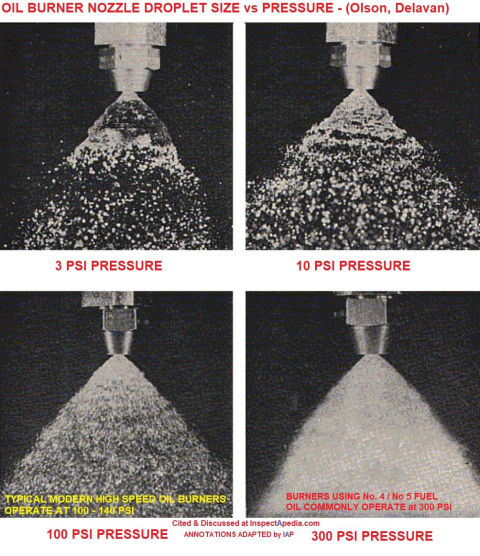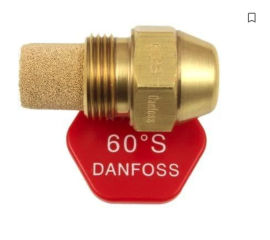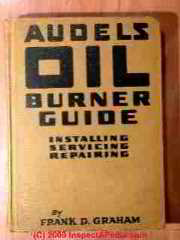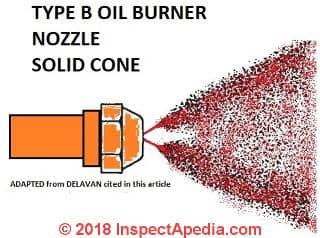 Oil Burner Nozzle Droplet Size
Oil Burner Nozzle Droplet Size
What is the size range & what affects the size of oil burner nozzle spray droplets?
- POST a QUESTION or COMMENT about oil burner nozzle function, adjustment, & repair
Oil Burner Nozzle output droplet size.
What is the range of sizes of the droplets produced by a typical residential oil burner?
Why does oil burner droplet size matter? What conditions cause changes in the oil burner droplet size and what is the effect of droplet size on oil burner operation?
Tamaño de gota de salida de la boquilla del quemador de aceite. ¿Cuál es el rango de tamaños de las gotas producidas por un quemador de aceite residencial típico?
¿Por qué es importante el tamaño de las gotas del quemador de aceite? ¿Qué condiciones provocan cambios en el tamaño de las gotas del quemador de aceite y cuál es el efecto del tamaño de las gotas en el funcionamiento del quemador de aceite?
In this article series we explain how to select & install an oil burner nozzle, we describe different oil burner nozzle firing rates & spray patterns; we discuss the setting of the gap and position of oil burner ignition electrodes, and we discuss how to diagnose oil burner electrodes or nozzle problems, how to inspect, clean, and adjust oil burner nozzles, electrodes, and air turbulators used on heating oil burners found on residential & light commercial oil burners.
InspectAPedia tolerates no conflicts of interest. We have no relationship with advertisers, products, or services discussed at this website.
- Daniel Friedman, Publisher/Editor/Author - See WHO ARE WE?
Oil Burner Nozzle Spray Droplet Size Range
Above: E.O. Olson, chief engineer for Delavan Fuel Metering Products (deceased) illustrated how increase in pressure affects the size and properties of heating oil fuel.
Notice that while residential oil burners typically operate in the 100 - 140 psi range, oil burners using heavier fuel oils operate often at 300 psi in order to "atomize" the fuel sufficiently for proper combustion.
Question: what is the oil burner droplet size for good combustion?
Saludos cordiales.
He leído que el tamaño de la partícula pulverizada del aceite combustible N.2. para que exista una buena combustión debe ser entre 10 y 50 micras.
Me podrían indicar si es correcto, y cual es el tamaño de las partículas pulverizadas a una presión de 100 psig. de las boquillas marca Delavan o de otras marcas. Mi correo ssatiar@hotmail.com. Gracias. - Á Ramírez A. - 2022/05/24
--- Translated to English for other readers ---
I have read that the size of the pulverized particle of fuel oil N.2. for there to be good combustion it must be between 10 and 50 microns.
Could you tell me if it is correct, and what is the size of the particles sprayed at a pressure of 100 psig. Delavan or other brand nozzles.]
Moderator reply: Oil burner nozzle droplet sizes vary between 5 & 250 microns, significant portion around 50 microns
@ Ramírez A. Thank you for a helpful question. .
Bottom line:
As discharged from the oil burner nozzle, oil burner droplet sizes range between 5 - 250u and a significant portion of the droplets will be in the 50u range.
That should be true across various oil burner nozzle brands, else they would not be so easily interchangeable.
Details
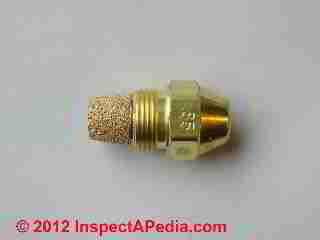 Delavan explains that individual droplets range from 0.0002 to 0.10 inches in diameter. That's about to 5 microns to 250 microns or 5 - 250u. The company explains:
Delavan explains that individual droplets range from 0.0002 to 0.10 inches in diameter. That's about to 5 microns to 250 microns or 5 - 250u. The company explains:
The exposed surface of a gallon of oil is thereby expanded to approximately 690,000 square inches of burning surface. Individual droplet sizes range from .0002 inch to .010 inch. The smaller droplets are necessary for fast quiet ignition and to establish a flame front close to the burner head. The larger droplets take longer to burn and help fill the combustion chamber. - Delavan, en A TOTAL LOOK at OIL BURNER NOZZLES [PDF] (2000) (live link below on this page)
In an older and classic oil burner guide by E.O.Olson, still widely read and cited, we read
A 1.00 GPH nozzle operating at 100 psi,
spraying No. 2 fuel oil breaks the fuel up into
droplets, which have an average diameter of
approximately .002 inch (50 microns). That
means that one gallon of fuel is broken up
into something like 55,000,000,000 droplets,
ranging in size from .0002" to .010" diameter.
By this process the surface area is increased
by approximately 3800 times. The resultant
area of one gallon of fuel is approximately
690,000 square inches.
The principal function of a nozzle then is
to break the fuel up into these very small
droplets. We use the term "atomize" to
describe this process even though it is not
strictly correct.
The size of these droplets is
very important in the performance of a
burner. Unfortunately there is as yet no
commercially feasible method of measuring
droplet sizes and all of the work that has been
done along that line has been on a laboratory
basis.
I - Olson, E.O., FUEL NOZZLES FOR OIL BURNERS, TECHNICAL ASPECTS OF APPLICATIONS [PDF] (live link below on this page)
- If we increase the oil burner fuel unit pressure above 100 psi we have more energy available to break oil into smaller droplets. If other variables (temperature, angle, viscosity) the droplet sizes will be reduced as pressure indreases.
- If we increase the oil burner nozzle discharge rate (go to a higher gph oil burner nozzle), while keeping spray angle and pressure the same, the oil droplet sie will increase. Olson points out that for this reason high input-rate oil burners work better using two or three (smaller) rather than one (large) nozzle to spray fuel into the combustion chamber.
Relationship of Heating Oil Viscosity & Oil Burner Nozzle Performance
If we increase the visosity of the heating oil, for example, by dropping its temperature, there are several effects, some of which, without Mr. Olson's help, would be guessed-at and wrong
- As heating oil viscosity increases the size of oil droplets discharged from the nozzle will increase: droplets will be larger.
A result can be un-stable flame and increased soot production (insufficient combustion air) - As heating oil viscosity increases the discharge rate from the nozzle increases.
Fed cold heating oil, the discharge rate of droplets at the nozzle actually falls off as the burner and oil heat-up. (Various nozzle designs respond to viscosity changes differently and some may be designed to handle higher viscosity or colder fuel.)
... This increase in discharge with increase in viscosity may not seem reasonable. However, laboratory data indicate that the phenomenon is real. ... - Olson - As heatinng oil viscosity is increased, the spray angle will be less-stable (and it decreases)
- At higher fuel unit pressures, the effect of viscosity on flow is reduced.
- Higher flow-rate nozzles (in gph or lph) are affected less by viscosity changes.
Olson points out that oil burners designed to burn heavy fuel such as No. 4 or No. 5 fuel oil manage to produce properly-sized oil droplets by a combination of pre-heating the fuel and using higher pressures.
As it's the fuel unit pressure, not its rotating speed that changes the droplet size distribution, I add that changing from those traditional oil burners that ran at 1725 RPM in Olson's era to modern high-speed oil burners that run at 3450 rpm probably makes little difference in the size of droplets discharged from the oil burner nozzle opening.
You will see across the various oil burner nozzle guides we provide at the end of this page that regardless of manufacturer, the principal differences among nozzles are firing rate and spray pattern. Nozzle selection charts don't themselves cite variations in fuel oil droplet size. I think, however, that oil burner nozzles will be designed to produce the optimal droplet size under various conditions.
Conclusion: overall, it's reasonable to accept the Delavan oil burner droplet size range 5 - 250u and to guess that Mr. Olson was right in citing that a significant portion of the droplets will be in the 50u range.
--- Translated to Spanish for our Latino readers ---
Como se descarga de la boquilla del quemador de aceite, el tamaño de las gotas del quemador de aceite varía entre 5 y 250 u y una parte significativa de las gotas estará en el rango de 50 u.
Eso debería ser cierto en varias marcas de boquillas de quemadores de aceite, de lo contrario no serían tan fácilmente intercambiables.
Detalles
Delavan explica que las gotas individuales varían de 0,0002 a 0,10 pulgadas de diámetro. Eso es alrededor de 5 micras a 250 micras o 5 - 250u. La empresa explica:
De este modo, la superficie expuesta de un galón de aceite se expande a aproximadamente 690 000 pulgadas cuadradas de superficie de combustión. Los tamaños de gota individuales varían de 0,0002 pulgadas a 0,010 pulgadas. Las gotas más pequeñas son necesarias para un encendido rápido y silencioso y para establecer un frente de llama cerca de la cabeza del quemador. Las gotas más grandes tardan más en quemarse y ayudan a llenar la cámara de combustión. - Delavan, en UNA MIRADA TOTAL a las BOQUILLAS DE LOS QUEMADORES DE ACEITE [PDF] (2000) (enlace en vivo más abajo en esta página)
En una guía más antigua y clásica de quemadores de aceite de E.O.Olson, todavía muy leída y citada, leemos
Una boquilla de 1,00 GPH que funciona a 100 psi y rocía aceite combustible n.° 2 descompone el combustible en gotitas, que tienen un diámetro promedio de aproximadamente 0,002 pulgadas (50 micrones). Eso significa que un galón de combustible se descompone en algo así como 55 000 000 000 de gotas, cuyo tamaño oscila entre 0,0002" y 0,010" de diámetro.
Mediante este proceso, el área superficial aumenta aproximadamente 3800 veces. El área resultante de un galón de combustible es de aproximadamente 690 000 pulgadas cuadradas.
Entonces, la función principal de una boquilla es romper el combustible en estas gotitas muy pequeñas. Usamos el término "atomizar" para describir este proceso aunque no es estrictamente correcto.
El tamaño de estas gotas es muy importante en el rendimiento de un quemador. Desafortunadamente, todavía no existe un método comercialmente viable para medir el tamaño de las gotas y todo el trabajo que se ha realizado en esa línea se ha realizado en laboratorio. I - Olson, E.O., BOQUILLAS DE COMBUSTIBLE PARA QUEMADORES DE ACEITE, ASPECTOS TÉCNICOS DE LAS APLICACIONES [PDF] (enlace en vivo debajo de esta página)
- Si aumentamos la presión de la unidad de combustible del quemador de aceite por encima de 100 psi, tenemos más energía disponible para romper el aceite en gotas más pequeñas. Si hay otras variables (temperatura, ángulo, viscosidad), el tamaño de las gotas se reducirá a medida que aumente la presión.
- Si aumentamos la tasa de descarga de la boquilla del quemador de aceite (vamos a una boquilla del quemador de aceite de mayor gph), mientras mantenemos el ángulo de rociado y la presión iguales, el tamaño de las gotas de aceite aumentará. Olson señala que, por esta razón, los quemadores de aceite de alta tasa de entrada funcionan mejor usando dos o tres boquillas (más pequeñas) en lugar de una (grande) para rociar combustible en la cámara de combustión.
Relación entre la viscosidad del aceite de calefacción y el rendimiento de la boquilla del quemador de aceite
Si aumentamos la viscosidad del aceite de calefacción, por ejemplo, bajando su temperatura, hay varios efectos, algunos de los cuales, sin la ayuda del Sr. Olson, serían adivinados y equivocados.
- A medida que aumenta la viscosidad del aceite de calefacción, aumentará el tamaño de las gotas de aceite descargadas desde la boquilla: las gotas serán más grandes.
- El resultado puede ser una llama inestable y una mayor producción de hollín (aire de combustión insuficiente)
- A medida que aumenta la viscosidad del aceite de calefacción, aumenta la tasa de descarga de la boquilla.
Alimentado con aceite de calefacción frío, la tasa de descarga de gotas en la boquilla en realidad disminuye a medida que el quemador y el aceite se calientan. (Varios diseños de boquillas responden a los cambios de viscosidad de manera diferente y algunos pueden estar diseñados para manejar combustibles de mayor viscosidad o más fríos).
... Este aumento de la descarga con el aumento de la viscosidad puede no parecer razonable. Sin embargo, los datos de laboratorio indican que el fenómeno es real. ... - Olson - A medida que aumenta la viscosidad del aceite de calefacción, el ángulo de pulverización será menos estable (y disminuirá)
- A presiones más altas de la unidad de combustible, se reduce el efecto de la viscosidad sobre el flujo.
- Las boquillas de mayor caudal (en gph o lph) se ven menos afectadas por los cambios de viscosidad.
Olson señala que los quemadores de aceite diseñados para quemar combustible pesado, como el fuel oil n.° 4 o n.° 5, logran producir gotas de aceite del tamaño adecuado mediante una combinación de precalentamiento del combustible y uso de presiones más altas.
Como es la presión de la unidad de combustible, no su velocidad de rotación, lo que cambia la distribución del tamaño de las gotas, agrego que cambiar de esos quemadores de aceite tradicionales que funcionaban a 1725 RPM en la era de Olson a los modernos quemadores de aceite de alta velocidad que funcionan a 3450 rpm probablemente hace poco. diferencia en el tamaño de las gotas descargadas desde la abertura de la boquilla del quemador de aceite.
Verá en las diversas guías de boquillas de quemadores de aceite que proporcionamos al final de esta página que, independientemente del fabricante, las principales diferencias entre las boquillas son la velocidad de encendido y el patrón de rociado. Las tablas de selección de boquillas no citan variaciones en el tamaño de las gotas de aceite combustible. Creo, sin embargo, que las boquillas de los quemadores de aceite estarán diseñadas para producir el tamaño de gota óptimo en diversas condiciones.
Oil Burner Nozzle Droplet Size Research
- Audel, OIL HEAT TEXTBOOK, Audel's OIL BURNER GUIDE, INSTALLATION, SEVICING, REPAIRING re-published here free, on-line, as a series of web pages is the original Audels Oil Burner Guide Installation, Servicing, Repairing, Frank D. Graham, 1940's edition (obsolete).
Updated versions of this guide are available in various editions, 1947, 1950, 1955, 1958, 1959, 1962, 1965, 1967, and at prices from around $3.00 to nearly $70.00 - useful for simple, clear, but not current, explanation of how heating equipment works.
The original retail price was $1.00. Used copies are available
Note that below both Danfoss and Hago oil burner nozzles are essentially the same company; check documentation and nozzle guides under both brand names and substitution charts.
- Beckett, SELECTING the PROPER [OIL BURNER] NOZZLE [PDF] Beckett Corp., - retrieved 2022/05/24, original source: https://www.beckettcorp.com/support/tech-bulletins/selecting-the-proper-nozzle/
- Beckett, THE EFFECT of HIGH OIL VISCOSITY on OIL BURNER PERFORMANCE [PDF] (1985) Beckett Corp., - retrieved 2022/05/24, original source: https://www.beckettcorp.com/support/tech-bulletins/the-effect-of-high-oil-viscosity-on-oil-burner-performance/
- Danfoss, FACTS WORTH KNOWING ABOUT OIL [BURNER] NOZZLES [PDF] Danfoss , Website: burner.danfoss.com or heating.danfoss.com Email: heating@danfoss.com - retrieved 2021/06/20 original source: https://assets.danfoss.com/documents/100682/AG045286452015en-010101.pdf
- Delavan, A TOTAL LOOK at OIL BURNER NOZZLES [PDF] (2000) Spray technologies, Fuel Metering Products Operation P.O. Box 969, Bamberg, South Carolina 29003 USA, Tel: (803) 245-4347 (800) 982-6943 Web: www.delavaninc.com
- Hago: A TECHNICIANS GUIDE to HAGO OIL BURNER NOZZLES [PDF] Danfoss, original publisher, Hago Manufacturing, Inc., retrieved 2021/06/20 original source: https://assets.danfoss.com/documents/49837/AX031086456770en-US0101.pdf
- Olson, E.O., FUEL NOZZLES FOR OIL BURNERS, TECHNICAL ASPECTS OF APPLICATIONS [PDF], E. O. Olson, Chief Engineer (deceased) Delavan Fuel Metering Products Operation, Bamberg, South Carolina, Delavan Fuel Metering Products, a reference guide for oil burner service technicians, Delavan Spray Technologies, Fuel Metering Products Division, PO Box 969, Bamberg SC 29003, Tel: 800-982-6943 or 803-245-4347, ( Delavan is a division of BF Goodrich); web search 12/30/2010, original source: http://www.delavaninc.com/pdf/Fuel_Nozzles_for_Burners.PDF
Editor's note: if you are only going to read one article to understand oil burner nozzles, make it this one.
...
Continue reading at OIL BURNER NOZZLE SUBSTITUTIONS - troubleshooting a new oil burner nozzle that doesn't seem to work, or select a topic from the closely-related articles below, or see the complete ARTICLE INDEX.
Or see these
Recommended Articles
- OIL BURNER ELECTRODES - how to set the electrodes on the oil burner once you've got the right nozzle
- OIL BURNER RUMBLING NOISE
- OIL BURNER NOZZLE GUIDE
- OIL BURNER NOZZLE REPLACEMENT: MATCH THE OLD ONE
- OIL BURNER NOZZLE FIRING RATE GPH
- OIL BURNER NOZZLE SPRAY ANGLE
- OIL BURNER NOZZLE SPRAY PATTERN
- OIL BURNER NOZZLE DROPLET SIZE RANGE
- OIL BURNER NOZZLE SELECTION TABLE
- OTHER OIL BURNER NOZZLE FEATURES
- OIL BURNER NOZZLE SUBSTITUTIONS - separate article
- OIL BURNER NOZZLE GUIDE BOOKS
- OIL BURNER INSPECTION & REPAIR - home
- OIL BURNER MANUALS
- OIL BURNER WONT RUN help diagnosing and fixing oil burners
Suggested citation for this web page
OIL BURNER NOZZLE GUIDE at InspectApedia.com - online encyclopedia of building & environmental inspection, testing, diagnosis, repair, & problem prevention advice.
Or see this
INDEX to RELATED ARTICLES: ARTICLE INDEX to HEATING OIL, OIL BURNERS, OIL FIRED HEATERS, OIL TANKS
Or use the SEARCH BOX found below to Ask a Question or Search InspectApedia
Ask a Question or Search InspectApedia
Try the search box just below, or if you prefer, post a question or comment in the Comments box below and we will respond promptly.
Search the InspectApedia website
Note: appearance of your Comment below may be delayed: if your comment contains an image, photograph, web link, or text that looks to the software as if it might be a web link, your posting will appear after it has been approved by a moderator. Apologies for the delay.
Only one image can be added per comment but you can post as many comments, and therefore images, as you like.
You will not receive a notification when a response to your question has been posted.
Please bookmark this page to make it easy for you to check back for our response.
IF above you see "Comment Form is loading comments..." then COMMENT BOX - countable.ca / bawkbox.com IS NOT WORKING.
In any case you are welcome to send an email directly to us at InspectApedia.com at editor@inspectApedia.com
We'll reply to you directly. Please help us help you by noting, in your email, the URL of the InspectApedia page where you wanted to comment.
Citations & References
In addition to any citations in the article above, a full list is available on request.
- Beckett Corporation, 38251 Center Ridge Rd., North Ridgeville, OH 44039 440-327-1060 Email: sales@beckettcorp.com supplies residential and commercial oil burners for boilers, furnaces, and water heaters - see www.beckettcorp.com/
- Domestic and Commercial Oil Burners, Charles H. Burkhardt, McGraw Hill Book Company, New York 3rd Ed 1969.
- In addition to citations & references found in this article, see the research citations given at the end of the related articles found at our suggested
CONTINUE READING or RECOMMENDED ARTICLES.
- Carson, Dunlop & Associates Ltd., 120 Carlton Street Suite 407, Toronto ON M5A 4K2. Tel: (416) 964-9415 1-800-268-7070 Email: info@carsondunlop.com. Alan Carson is a past president of ASHI, the American Society of Home Inspectors.
Thanks to Alan Carson and Bob Dunlop, for permission for InspectAPedia to use text excerpts from The HOME REFERENCE BOOK - the Encyclopedia of Homes and to use illustrations from The ILLUSTRATED HOME .
Carson Dunlop Associates provides extensive home inspection education and report writing material. In gratitude we provide links to tsome Carson Dunlop Associates products and services.


